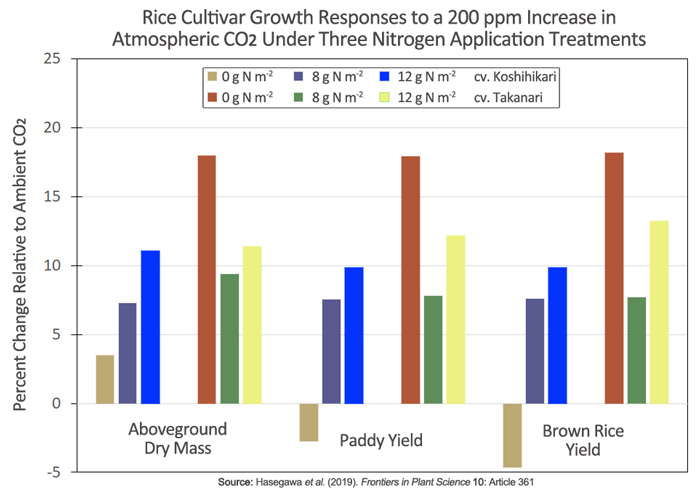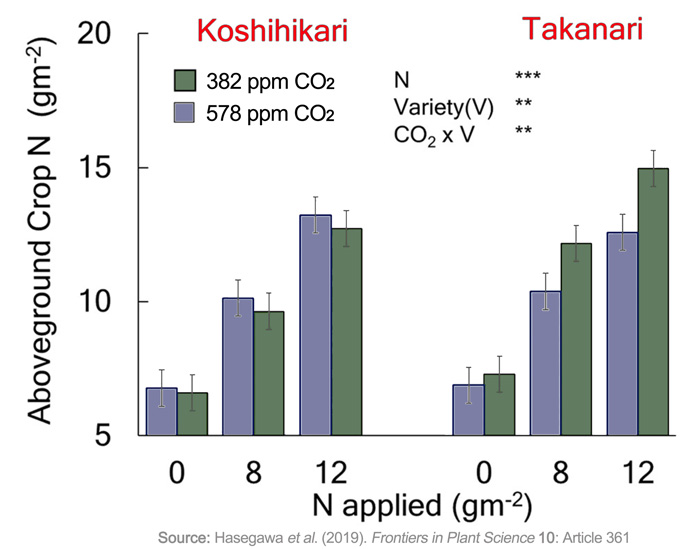| Tweet | Follow @co2science |
Paper Reviewed
Hasegawa, T., Sakai, H., Tokida, T., Usui, Y., Nakamura, H., Wakatsuki, H., Chen, C.P., Ikawa, H., Zhang, G., Nakano, H., Matsushima, M.Y. and Hayashi, K. 2019. A high-yielding rice cultivar "Takanari" shows no N constraints on CO2 fertilization. Frontiers in Plant Science 10: Article 361, doi: 10.3389/fpls.2019.00361.
In providing the background for their study, Hasegawa et al. (2019) note that there remains uncertainty in projecting the positive effects of atmospheric CO2 enrichment, i.e., the CO2 fertilization effect, on future crop yields because the strength of the CO2 fertilization response depends on several factors, including water, nutrients, temperature, crop species and genotypes. Thus, they say that in order to "exploit the positive effects of elevated CO2 on crop production in the future, the mechanisms by which the CO2 fertilization effects vary must be better understood." And so it was that they set out to study the interactive effects of elevated CO2 and nitrogen (N) supply on two rice cultivars: Koshihikari and Takanari, the former of which is a standard japonica cultivar while the latter is a high-yielding indica cultivar.
In conducting their experiment, the researchers grew both cultivars outdoors in a free-air CO2 enrichment (FACE) environment for three consecutive growing seasons (2012-2014) at the Tsukuba FACE facility in Tsukubamirai, Ibaraki, Japan. Ambient and enriched CO2 treatments levels varied little across the three years and averaged 382 ppm and 578 ppm, respectively. Nitrogen supply included treatments of no N added, 8 g m-2 added and 12 g m-2 added.
Results of the study revealed that aboveground biomass increased in both cultivars under elevated CO2 at all N treatment levels (see Figure 1, left side panel). However, the percent increase in this parameter (relative to ambient CO2 levels) diminished in the lower-yielding Koshihikari cultivar as the amount of N applied decreased, whereas for higher-yielding Takanari the greatest relative CO2 biomass response was observed in the treatment with no added N.
Similar findings were also observed for paddy (unhulled grain) yield and brown rice yield, where the greatest relative CO2-induced increases for Takanari were observed in the no N added treatment, followed by that obtained in the 12 and 8 g N m-2 added treatments (see Figure 1). For Koshihikari, under elevated CO2 the highest paddy and brown rice yield enhancements occurred at the highest level of N application, diminishing slightly in the 8 g N m-2 treatment and then turning negative when no N was applied (again, see Figure 1).
Commenting on the above findings, Hasegawa et al. say the N-limiting influence of the CO2 fertilization effect on Koshihikari resulted from a reduction in the allocation of biomass into its grains. In contrast, they confirm that "the N-limited CO2 fertilization effect does not hold for [the] high-yielding indica cultivar [Takanari]." This is largely because of enhanced crop N uptake that occurs in Takanari, even without the application of N fertilizer as shown in Figure 2.
Hasegawa et al. also examined the percent of grain chalkiness present in the two cultivars, which parameter is utilized as an indicator of grain appearance quality. Here, they report that the lower-yielding Koshihikari had consistently higher levels of grain chalkiness (i.e., reduced grain appearance quality) than Takanari. Thus, the twelve scientists who conducted this study conclude that, as the air's CO2 content rises in the future, the Takanari cultivar will likely "retain its high yield advantage over Koshihikari with limited increase in chalkiness even under limited N conditions." What is more, they say Takanari "could be a useful genetic resource for improving N use efficiency [in other cultivars] under elevated CO2," which will likely ensure that future rice yields will increase in quantity without a sacrifice to quality. And that is great news for the planet's producers and consumers of this important food crop.

Figure 1. Percent change in aboveground dry mass, paddy (unhulled grain) yield and brown rice yield of two rice cultivars in response to a 200 ppm CO2 increase under three different applications of nitrogen (N). Source: this graphic was created using data obtained in Tables 3 and 4 of Hasegawa et al. (2019).

Figure 2. The effects of nitrogen (N) application and atmospheric CO2 concentration on the aboveground crop N of two rice cultivars measured at maturity. *** and ** indicate significant differences at P = 0.001 and 0.01, respectively. Vertical bars are the standard errors of the residual of the ANOVA. Source: Adapted from Hasegawa et al. (2019).




